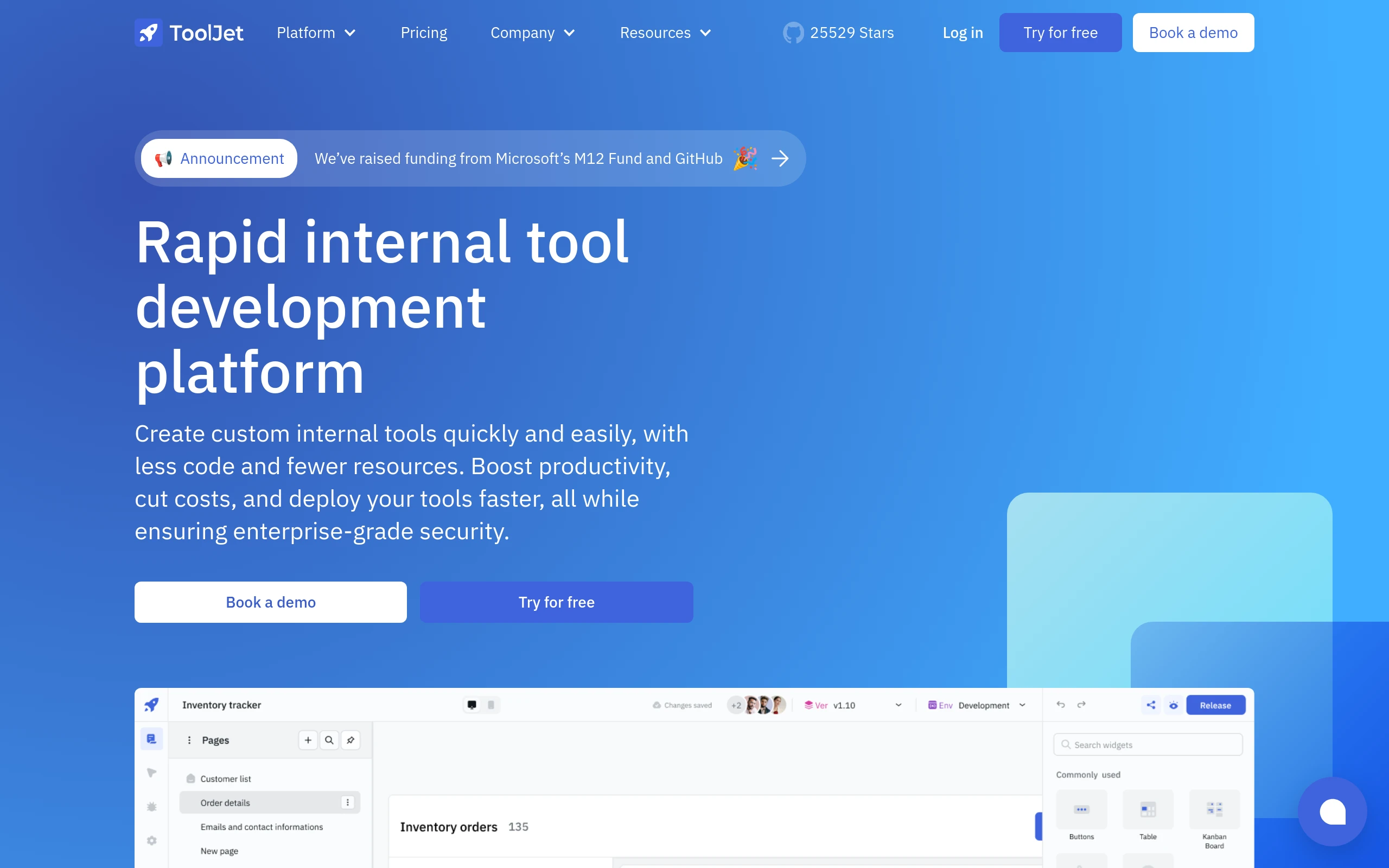
ToolJet
26.7k 3.3kWhat is ToolJet ?
ToolJet is an open-source low-code framework to build and deploy internal tools with minimal engineering effort. ToolJet’s drag-and-drop frontend builder allows you to create complex, responsive frontends within minutes. Additionally, you can integrate various data sources, including databases like PostgreSQL, MongoDB, and Elasticsearch; API endpoints with OpenAPI spec and OAuth2 support; SaaS tools such as Stripe, Slack, Google Sheets, Airtable, and Notion; as well as object storage services like S3, GCS, and Minio, to fetch and write data.

ToolJet features
- Visual App Builder: 40+ built-in responsive components, including Tables, Charts, Lists, Forms, and Progress Bars.
- ToolJet Database: Built-in no-code database.
- Multi-Page: Build an application with multiple pages.
- Multiplayer editing: Allows simultaneous app building by multiple developers.
- 40+ data sources: Integrate with external databases, cloud storage, and APIs.
- Desktop & mobile: Customize layout widths to fit various screen sizes.
- Self-host: Supports Docker, Kubernetes, Heroku, AWS EC2, Google Cloud Run, and more.
- Collaborate: Add comments anywhere on the canvas and tag your team members.
- Extend with plugins: Use our command-line tool to easily bootstrap new connectors.
- Version control: Manage multiple application versions with a structured release cycle.
- Run JS & Python code: Execute custom JavaScript and Python snippets.
- Granular access control: Set permissions at both group and app levels.
- Low-code: Use JS code almost anywhere within the builder, such as setting text color based on status with
status === 'success' ? 'green' : 'red'. - No-code query editors: Query Editors are available for all supported data sources.
- Join and transform data: Transform query results using JavaScript or Python code.
- Secure: All the credentials are securely encrypted using
aes-256-gcm. - Data Privacy: ToolJet serves solely as a proxy and does not store data.
- SSO: Supports multiple Single Sign-On providers.
Quickstart with ToolJet
The easiest way to get started with ToolJet is by creating a ToolJet Cloud account. ToolJet Cloud offers a hosted solution of ToolJet. If you want to self-host ToolJet, kindly proceed to deployment documentation.
You can deploy ToolJet on Heroku and DigitalOcean using one-click-deployment.
Try using Docker
Want to give ToolJet a quick spin on your local machine? You can run the following command from your terminal to have ToolJet up and running right away.
docker run \ --name tooljet \ --restart unless-stopped \ -p 80:80 \ -v tooljet_data:/var/lib/postgresql/13/main \ tooljet/try:latestTutorials and examples
Time Tracker Application
Build your own CMS using low-code
AWS S3 Browser
Documentation
Documentation is available at https://docs.tooljet.com
Self-hosted
You can use ToolJet Cloud for a fully managed solution. If you want to self-host ToolJet, we have guides on deploying ToolJet on Kubernetes, AWS EC2, Docker, Heroku, and more.
| Provider | Documentation |
|---|---|
| Digital Ocean | Link |
| Docker | Link |
| Heroku | Link |
| AWS EC2 | Link |
| AWS ECS | Link |
| OpenShift | Link |
| Helm | Link |
| AWS EKS (Kubernetes) | Link |
| GCP GKE (Kubernetes) | Link |
| Azure AKS (Kubernetes) | Link |
| Azure Container | Link |
| Google Cloud Run | Link |
| Deploying ToolJet client | Link |
| Deploying ToolJet on a Subpath | Link |
Marketplace
ToolJet can now be found on both AWS and Azure Marketplaces, making it simpler than ever to access and deploy our app-building platform.
Find ToolJet on AWS Marketplace here and explore seamless integration on Azure Marketplace here.